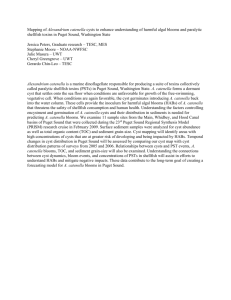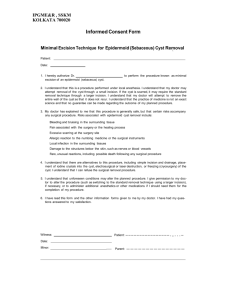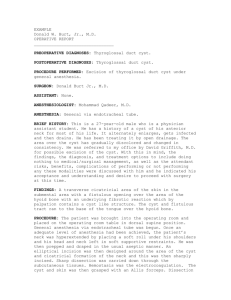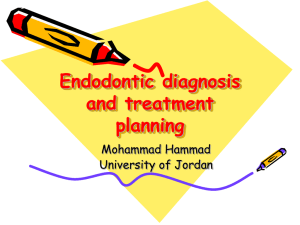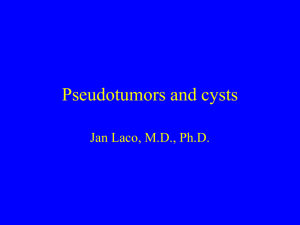PATHOLOGY OF THE TEETH
advertisement
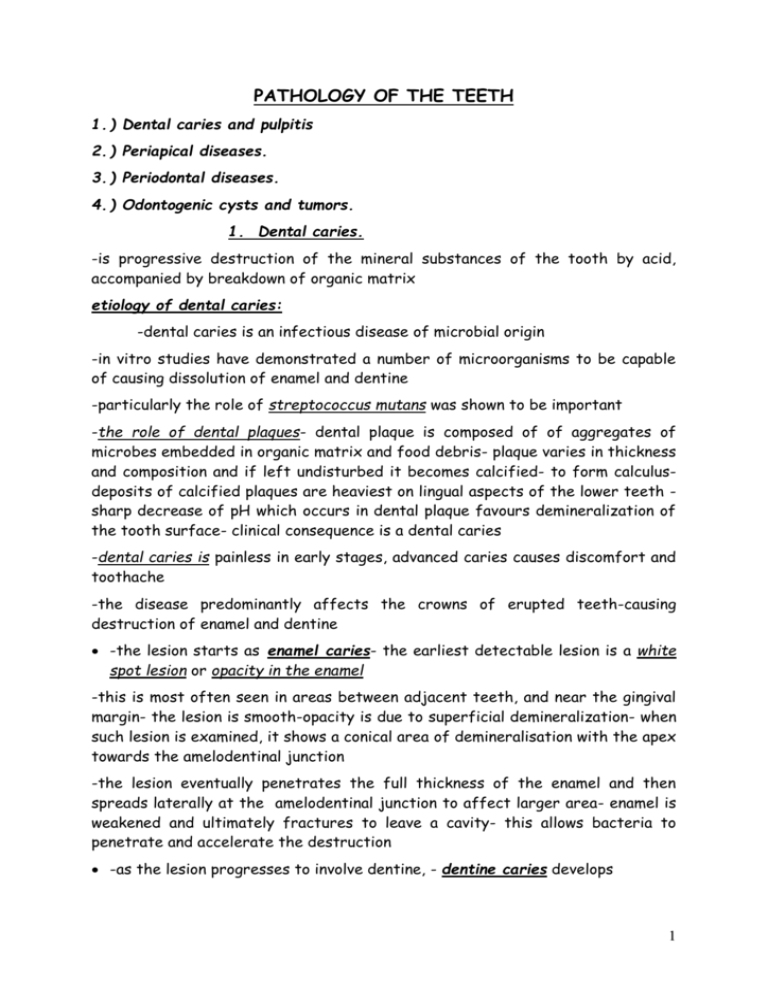
PATHOLOGY OF THE TEETH 1. ) Dental caries and pulpitis 2. ) Periapical diseases. 3. ) Periodontal diseases. 4. ) Odontogenic cysts and tumors. 1. Dental caries. -is progressive destruction of the mineral substances of the tooth by acid, accompanied by breakdown of organic matrix etiology of dental caries: -dental caries is an infectious disease of microbial origin -in vitro studies have demonstrated a number of microorganisms to be capable of causing dissolution of enamel and dentine -particularly the role of streptococcus mutans was shown to be important -the role of dental plaques- dental plaque is composed of of aggregates of microbes embedded in organic matrix and food debris- plaque varies in thickness and composition and if left undisturbed it becomes calcified- to form calculusdeposits of calcified plaques are heaviest on lingual aspects of the lower teeth sharp decrease of pH which occurs in dental plaque favours demineralization of the tooth surface- clinical consequence is a dental caries -dental caries is painless in early stages, advanced caries causes discomfort and toothache -the disease predominantly affects the crowns of erupted teeth-causing destruction of enamel and dentine -the lesion starts as enamel caries- the earliest detectable lesion is a white spot lesion or opacity in the enamel -this is most often seen in areas between adjacent teeth, and near the gingival margin- the lesion is smooth-opacity is due to superficial demineralization- when such lesion is examined, it shows a conical area of demineralisation with the apex towards the amelodentinal junction -the lesion eventually penetrates the full thickness of the enamel and then spreads laterally at the amelodentinal junction to affect larger area- enamel is weakened and ultimately fractures to leave a cavity- this allows bacteria to penetrate and accelerate the destruction -as the lesion progresses to involve dentine, - dentine caries develops 1 -enamel is an extracellular matrix and does not contain any living cells, whereas dentine is penetrated by the cell processes of the odontoblasts that lie on its pulpal aspect -once caries begins to affect dentine - the destruction of organic matrix is accompanied by defensive reaction of the pulp-dentine complex (odontoblasts produce irregular secondary dentine) and by inflammatory reaction within the pulp- bacteria invade and extend down the dentinal tubules- focal areas become distended with masses of bacteria to form liquefaction foci- which may fuse to form transverse clefts in dentine -in rapidly progressing caries the protective secondary dentine is breached and bacteria reach the pulp -with the further advance of destruction- dentine is broken- direct bacterial infection of the pulp occurs -acute pulpitis- the earliest stage of pulpal inflammation is hyperemia and leukocytic emmigration in the area of pulp underlying the zone of cariesthere is progressive accumulation of leukocytes- which forms microabscesses -the inflammation spreads to involve the whole pulp, the inflammatory exudate increases the intrapulpal pressure (pain)- impairing the pulpal circulation - this is in most instances followed by complete pulp necrosis, with spread of infection and inflammation into the tissues around the root apex of the tooth -this leads to formation of apical abscess- these stages of disease are accompanied by severe pain (due to severe swelling of the tissue) - apical abscess develops around the apex of tooth - the abscess enlarges and may drain through the gingiva -if the abscess is not able to establish drainage through the surface of the skin or into the oral cavity, acute inflammation continues and spread diffusely to soft tissues of the floor of mouth - two extremely dangerous complications may develop: Ludwig's angina and cavernous sinus thrombosis Ludwig's angina - presents a swelling of the floor of mouth, tongue and submandibular region-leads to restricted neck movement, dysphagia, sore throat, dyspnea and possibly respiratory obstruction secondary to laryngeal edema clinically- fever, chills, leukocytosis and elevated sedimentation rate- treatmentwith modern antibiotic therapy, mortality associated with Ludwig angina has diminished from 60 % to 8 % cavernous sinus thrombosis- presents as edematous periorbital enlargement with involvement of eyelids and conjuctiva, clinically- fever. chills tachycardia, vomiting- pain in eyeball and menigitis- brain abscess may result 2 -chronic hyperplastic pulpitis (pulp polyp)- this is a unique pattern of pulpal inflammation, this condition occurs in children or young adults- the most frequently involved teeth are the deciduous molars- which have large pulp chambers -although necrosis is the most common sequel of pulpal inflammation, the pulp may survive, even when there has been gross destruction of the overlying enamel and dentine- the remaining pulpal tissue proliferates to form granulation tissue which bulges into the caries cavity as a polyp- the surface may become epithelialised and the polyp becomes more fibrotic 2. chronic periapical granuloma (chronic apical periodontitis) -in chronic stage apical abscess is replaced by apical granuloma, that may transform into periapical dental cyst -periapical infection- infection may extend from the tooth pulp to the apical periodontium- resulting in an inflammatory lesion that progresses through different stages to -periapical granuloma -periapical granuloma refers to a mass of chronically inflamed granulation tissue at the apex of a nonvital tooth characterized by bone resorption, and mixed inflammatory infiltrate -formation of periapical inflammatory lesion represents a defensive reaction secondary to the presence of bacteria in the root canal -periapical granuloma either may demonstrate acute exacerbation with new abscess formation or undergoes epithelialization to form cystic structure called radicular cyst (periapical dental cyst) -epithelium at the apex of a nonvital tooth can be stimulated by inflammation to form a true epithelium-lined cyst, the source for this epithelium are usually rests of Malassez, cyst development is common, -periapical cyst represents a fibrous connective tissue wall lined by epithelium with lumen containing fluid and cellular debris and some inflammatory cells Treatment: -localized pulp abscess-simple antibiotics may be sufficient treatment drainage and installation of -periapical granuloma and periapical cysts are treated in the same manner-succesful treatment centers on reduction of activity of bacteria, nonrestorable teeth must be extracted, followed by curretage of all apical soft tissue, if the tooth is maintained, root canal therapy can be performed3. Gingivitis and periodontal diseases 3 -gingivitis and periodontal diseases constitute a group inflammatory conditions of the tooth-supporting structures of destructive -inflammation - acute gingivitis, which may be progressive to destructive periodontitis-both result in an instability, and loss of the tooth periodontitis- is an inflammatory disease that affects the supporting structures of the teeth, such as periodontal ligaments, alveolar bone and cementum -with progression, the process leads to the loss of attachment with destruction of the periodontal ligament and alveolar bone -it is now believed that periodontitis is caused not by mere presence of dental plaque, but by change in composition of bacterial flora within the plaque-only few types of bacteria were shown to be related to p.-itis, such as type of actinobacillus... -cause of p.-itis has not been completely delineated, but three possible hypotheses exist, direct destruction by bacteria or their products, immune hyper-responsiveness and immune deficiency 4. ODONTOGENIC CYSTS AND TUMORS 1) CYSTS OF THE JAW - are very common- can be developmental or inflammatory, many of them occur in relation to the teeth- odontogenic cysts, the other cysts are not related to teeth- non-odontogenic cysts A) Developmental cysts-two major type can be distinguished : 1) odontogenic gingival cyst of infants (Epstein pearls)- is small cyst arising from epithelial cell rests in the alveolar mucosa of infants, -these lesions are commonly seen at birth- are white to yellow nodules histologically-thin lining of stratified squamous epithelium, keratin fills the cyst cavity odontogenic keratocyst (primordial cyst)- a cyst arising in the tooth-bearing areas of the jaws, or posterior to third molar, characterized by a thin fibrous capsule and lining of keratinized squamous epithelium -the mandible is involved much more frequently than maxilla, about half of cases occurs at the angle of the mandible, radiographically- unilocular ot multilocular pattern -can be associated with Gorlin syndrome (nevoid basal cell carcinoma syndrome)is inherited as autosomal-dominant trait with hgih penetrance, is characterized 4 by multiple basal cell carcinomas of the skin, multiple jaw cysts, vertebral anomalies, epidermal cysts and intracranial calcifications -locally aggressive growth, recurrence rate 25-30% histologically: thin fibrous wall, lined by thin epithelial lining composed of squamous cells with parakeratosis, if inflammed-the wall and fibrous capsule may be thickened -most keratocysts are isolated lesions, they have marked tendency to recur dentigerous (follicular) cyst -arises from the epithelial residues of the tooth follicle, associated with failure of eruption of involved tooth, most commonly located in the lower third molar -the wall of cyst is formed by the dental follicle-the wall is fibrous, the lining is of stratified squamous epithelium with mucous metaplasia -if the unerupted tooth is present in the wall of the cyst, then it is called dentigerous cyst eruption cyst-occurs in the gingiva averlying tooth about to erupt, seen in children, painless, lined by stratified squamous epithelium lateral periodontal cyst- uncommon cyst, mostly located in mandible anterior to molar region, lined by squamous or columnar epithelium, can erode the bone gingival cyst of adults- accounts for 0.5% of jaw cysts, painless slowly enlarging, mandible more commonly affected,lined by flattened squamous epithelium glandular odontogenic cyst (sialo-odontogenic cyst)- can be multi-or unilocular, is characterized by papillary luminal surface lined by eosinophilic cuboidal or ciliated cells, focally with mucin producing cells 2) non-odontogenic-these uncommon cysts of the jaw are formed without association with teeth, they usually occur in the midline of the anterior part of the maxilla, the variant include nasopaltine, median palatine, palatine papilla amd median alveolar cyst nasopalatine duct (incisive canal) cyst-is most common of them, slowly growing cyst -sweeling in the midline of the palate-discharge and pain histologically: the lining is varialbe, it consists of either ciliated columnar (respiratory) or squamous epithelium, mucous glands may be present B) Inflammatory cystsradicular cyst- most common, is the result of the process of reepithelization of periapical granuloma- chronic inflammatory response initiates proliferation of 5 Malassez epithelial nests, and epithelium starts to penetrate the granuloma, central cystic cavity is formed and lined by squamous cell epithelium 2) The tumors of the jaw -the jaws are subject to the same range of tumors as occur elswhere in the body -in addition- dental apparatus may give rise to the odontogenic tumors -these tumors are rare, and only ameloblastoma is more common -ameloblastoma- is the most common odontogenic tumor, it accounts for about 1-2% of all jaw tumors, occurs mainly in 2.-4. decades, most often in the molar region of the mandible, microscopically: the tumor is composed of islands and cords of odontogenic neoplastic epithelium within the fibrous stroma -the epithelium in ameloblastoma resembles that seen in the tooth germ -the cells at the periphery of epithelial islands are cuboidal or low columnar and have their nuclei oriented towards the centre of epithelial cord- reversed polarity -many histological patterns may occur, including anastomosing cords and plexiform patterns, cystic, pseudocystic, and solid regions -ameloblastoma is not encapsulated, capable of local destruction and invasioncomplete local excision is a good treatment clinically: locally aggressive, may recur after surgical removal, rare development of metastasis -squamous odontogenic tumors- uncommon, arises in the periodontal ligament, it consists of islands and nests of squamous epithelium in dense desmoplastic stroma -epithelium is cytologically bland- tumor may grow aggressively, but does not recur after surgical removal -adenomatoid odontogenic tumor-arises in younger age group, most common site is the maxillary canine and incisor region -benign -the tumor is well circumscribed, composed of bilayered epithelial nests and duct-like structures, occasionally there are focal deposits of enamel-like extracellular material or calcification -calcifying epithelial odontogenic tumor (Pindborg tumor)- rare, form multilocular masses with variable degree of calcifications and bone expansion histologically highly variable appearance- giant multinuclear cells, prominent nuclear polymorphism, but few mitoses -locally infiltrative - similar aggressiveness as inameloblastoma, low tendency to progression, no metastasis 6 -odontogenic ghost cell tumor (calcifying odontogenic cyst, Gorlin cyst)- produces painless swelling, majority arise in the mandible, the tumor is benign -histologically composed of the cells with abnormal keratinization- with presence of so called ghost cells-large pale stained cells shadow-like -ameloblastic fibroma- rare tumor, more comonly seen in children, composed of stroma that resembles primitive dental pulp- very cellular with little collagen formation, and benign looking epithelial nests -benign tumor, it can recur -odontoma complex and compound- among most common odontogenic tumors, they are considered to be developmental anomalies- hamartomas -consists mainly of enamel and dentin, with variable amounts of pulp and cementum the compound odontoma- is composed of multiple, small tooth-.like structures the complex odontoma-consists of complex masses of enamel and dentin, which bears no anatomic resemblance to a tooth 7


